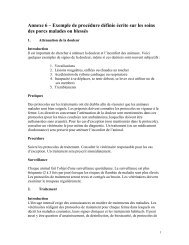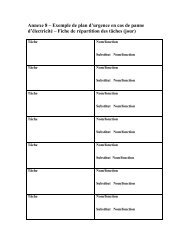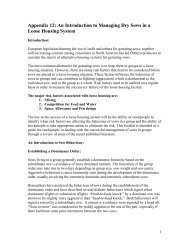Appendix 9: Sample Farrowing Standard Operating Procedure - CQA
Appendix 9: Sample Farrowing Standard Operating Procedure - CQA
Appendix 9: Sample Farrowing Standard Operating Procedure - CQA
You also want an ePaper? Increase the reach of your titles
YUMPU automatically turns print PDFs into web optimized ePapers that Google loves.
and farrowing quarters are still relatively clean; and the piglet is well protected<br />
with antibodies from the colostrum of the sow. Tails should be docked about one<br />
inch from the point where the tail joins the body. Docking too short might lead to<br />
rectal prolapses or rear leg paralysis in later life. Use a disinfected side cutter to<br />
dock tails. A specially designed, heated cutter that will cauterize the wound can<br />
also be used successfully. Very sharp instruments should be avoided because of<br />
their increased potential to cause excessive bleeding.<br />
• Supplemental iron: Injection of iron is preferred over oral administration<br />
because iron is poorly absorbed from the piglet’s digestive tract. Injectable iron<br />
products are available in both 100 and 200 mg of iron/cc concentrations. Iron<br />
dextran is one of the most common products used. A single injection of 200 mg<br />
of iron before three days of age is sufficient to prevent anemia. Iron injections<br />
should be administered in the neck muscle behind the ear. Iron should not be<br />
injected in the ham as damage to the sciatic nerve may occur or the muscle may<br />
be stained which will reduce quality of the ham at slaughter. Stretch the skin<br />
before injecting iron then release the skin after injection. This practice will help<br />
prevent the iron from leaking out of the injection site. Do not overdose with iron<br />
as too much iron can be very toxic to the piglet.<br />
• Identification: Piglets may be identified in some way at processing. In<br />
commercial settings, identification usually takes the form of ear notches or ear<br />
tattoos. Animal care workers need to carefully identify piglets as poorly placed<br />
notches or tattoos are difficult to read when pigs get older.<br />
• Castration: Castration is best done when the piglets are relatively small and<br />
before 14 days of age.<br />
• Creep feeding. Creep feeding is recommended beginning at about 10 days of age<br />
for piglets weaned at three weeks of age and later.<br />
• Water: Piglets should have access to a source of water.<br />
• Euthanasia: Check with barn manager.<br />
3






